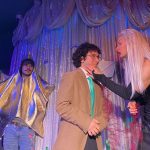By Jack Robert Stacey | Editor-in-Chief
Of all the annual traditions and performances that take place throughout the wintertime, there is perhaps no clearer example of ÔÇÿChristmas on the stageÔÇÖ than the British pantomime. With over 100 separate productions scheduled to take place across the UK this year, this unique combination of music, fairytales and over-exaggerated slapstick humour remains to be an integral part of the holiday season for many people.
These familiar pantomime elements were on full display in ÔÇÿThe Yellow Brick RoadÔÇÖ, a production based on L. Frank BaumÔÇÖs now iconic childrenÔÇÖs novel, The Wonderful Wizard of Oz.
Written and performed by members of Act One ÔÇô the largest student-led drama society at Cardiff University ÔÇô The Yellow Brick Road follows Dorothy (Morna Muzawazi) as she bands together with an unlikely group of misfits (Zachary Brown, James Holland, and Lucie Rhiannon Williams) and embarks on a turbulent journey towards the Emerald City. Despite firmly clinging to L. Frank BaumÔÇÖs overarching storyline, the show found a number of new, inventive ways to adapt on and openly satirize the tropes featured in its source material.
ÔÇ£the show found a number of new, inventive ways to adapt on and openly satirize the tropes featured in its source material.ÔÇØ
Kyle OkaneÔÇÖs performance as the Good Witch ÔÇÿGlindaÔÇÖ was the standout example of this inventiveness. Playing the quintessential pantomime dame, Okane immediately set the tone of the performance with his overly flamboyant behaviour and drew out a majority of the early laughs by flirting with specific members of the audience.
Okane, along with the rest of the cast, seemed comfortable with both reciting their lines and making quippy, off the cuff remarks back at the audience. As a key element of so-called ÔÇÿpantomime cultureÔÇÖ, the fourth wall was also broken down by members of the audience who frequently called out with quips of their own. Understandably, this open dialogue occasionally led cast members to lose track of their place, but the cast were ultimately able to wrestle control back from the audience when needed ÔÇô An aspect that was especially impressive given the closeness of the cast to their audience.
Whilst the show holds its own well throughout, the relatively small size of the stage clearly caused a variety of logistical limitations for the larger scenes of the performance where the cast were forced to huddle closely together.
These limitations were perhaps most obvious in the final confrontation with the ÔÇÿWicked Witch of the WestÔÇÖ (Mimi Brown as ÔÇÿElphabaÔÇÖ) in which the entire cast stood together on the stage. This admittedly led the scene to feel somewhat cluttered, losing the more intimate focus of first act where the action was centralised on one or two performers rather than spread across the entirety of the stage.
Despite these challenges, however, the cast and crew were able to successfully offset these issues with a range of dynamic scenes and musical segments which focus on horizontal movement. In general, the script arguably managed to achieve more within the tight confines of their restrictive space than it otherwise might have done with an expansive stage area.
ÔÇ£the cast arguably managed to achieve more within the tight confines of their restrictive space than they otherwise might have done with an expansive stage areaÔÇØ
This creative use of the stage was best demonstrated towards the end of the performance in which, following a brief interval, Dorothy and her band of misfits reach the fabled Emerald City.
In this, the second and final act of the performance, the narrative shifted to focus more on the two comic pairings of ElphabaÔÇÖs ÔÇÿFlying MonkeysÔÇÖ and the Munchkins; both of which had felt slightly underused in the previous act. This shift was especially impactful for Meg Shergold and Cleo Widdicombe who, as the central comedy duo, found their footing in these later scenes and delivered some genuinely humorous back-and-forth exchanges.
The defining aspect of the second act, however, was Maisie GrangerÔÇÖs performance as the enigmatic and vaudevillian ÔÇÿWizardÔÇÖ. Darting around the stage with all the enthusiasm of a carnival barker, GrangerÔÇÖs take on the character took a decidedly more cartoonish and charismatic approach than former representations which, to her credit, provided some much needed energy to draw the performance towards its conclusion.
Overall, Act OneÔÇÖs performance of ÔÇÿThe Yellow Brick RoadÔÇÖ was both a familiar and thoroughly engaging experience that closed out the year well in its own, unique way. As an adaptation that balanced L. Frank BaumÔÇÖs original tale with the comedic styling of a modern pantomime, the performance felt like a fresh and original take on this traditional, well-trodden narrative.
[mks_button size=”small” title=”Jack Robert Stacey” style=”squared” url=”https://cardiffstudentmedia.co.uk/gairrhydd/jack-robert-stacey/” target=”_self” bg_color=”#000000″ txt_color=”#FFFFFF” icon=”” icon_type=”” nofollow=”0″] [mks_button size=”small” title=”Review” style=”squared” url=”https://cardiffstudentmedia.co.uk/gairrhydd/review/” target=”_self” bg_color=”#000000″ txt_color=”#FFFFFF” icon=”” icon_type=”” nofollow=”0″]┬á




